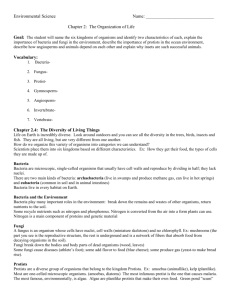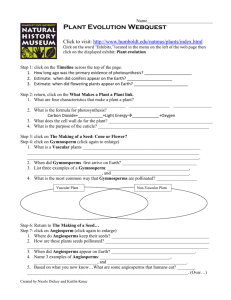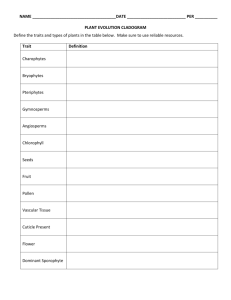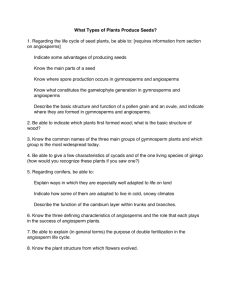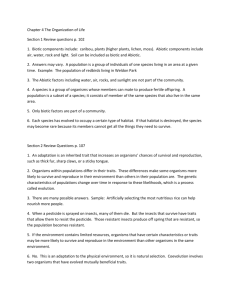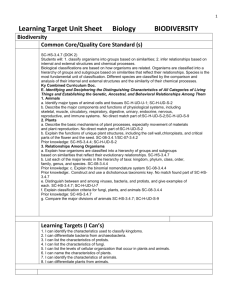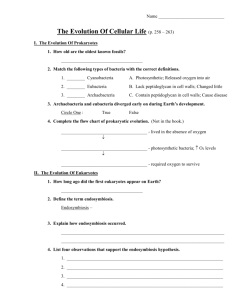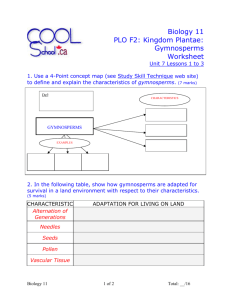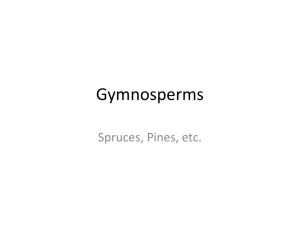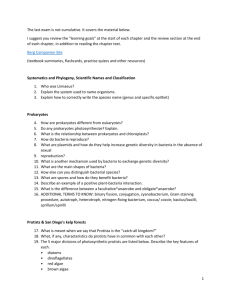Chapter 14 EARLY EARTH
advertisement
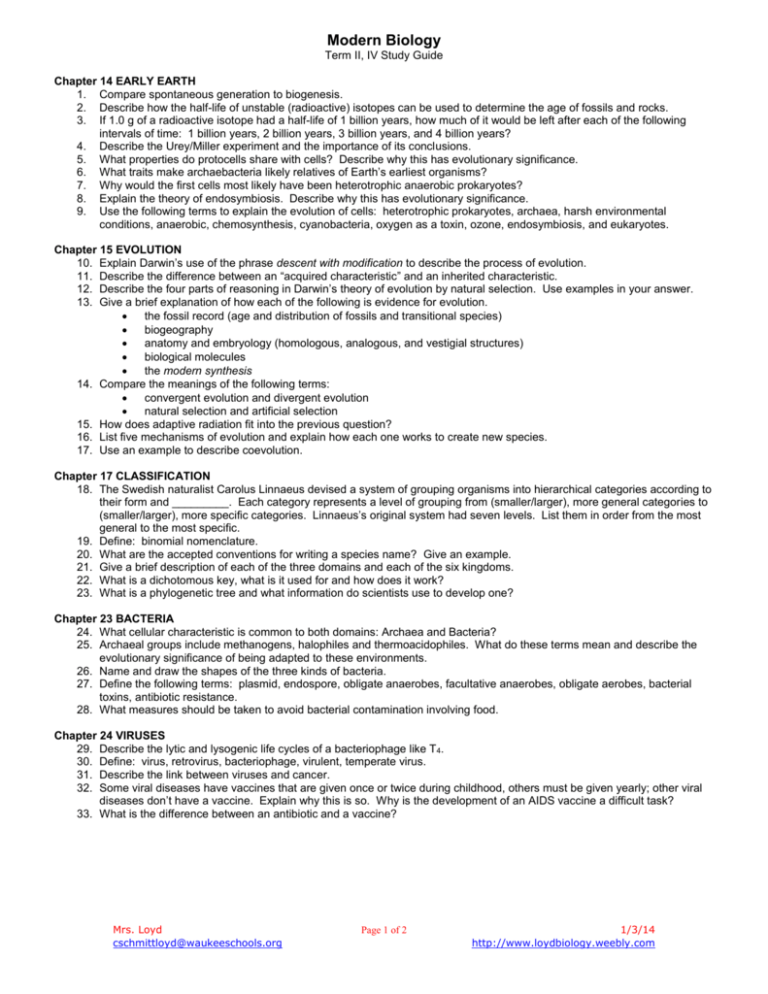
Modern Biology Term II, IV Study Guide Chapter 14 EARLY EARTH 1. Compare spontaneous generation to biogenesis. 2. Describe how the half-life of unstable (radioactive) isotopes can be used to determine the age of fossils and rocks. 3. If 1.0 g of a radioactive isotope had a half-life of 1 billion years, how much of it would be left after each of the following intervals of time: 1 billion years, 2 billion years, 3 billion years, and 4 billion years? 4. Describe the Urey/Miller experiment and the importance of its conclusions. 5. What properties do protocells share with cells? Describe why this has evolutionary significance. 6. What traits make archaebacteria likely relatives of Earth’s earliest organisms? 7. Why would the first cells most likely have been heterotrophic anaerobic prokaryotes? 8. Explain the theory of endosymbiosis. Describe why this has evolutionary significance. 9. Use the following terms to explain the evolution of cells: heterotrophic prokaryotes, archaea, harsh environmental conditions, anaerobic, chemosynthesis, cyanobacteria, oxygen as a toxin, ozone, endosymbiosis, and eukaryotes. Chapter 15 EVOLUTION 10. Explain Darwin’s use of the phrase descent with modification to describe the process of evolution. 11. Describe the difference between an “acquired characteristic” and an inherited characteristic. 12. Describe the four parts of reasoning in Darwin’s theory of evolution by natural selection. Use examples in your answer. 13. Give a brief explanation of how each of the following is evidence for evolution. the fossil record (age and distribution of fossils and transitional species) biogeography anatomy and embryology (homologous, analogous, and vestigial structures) biological molecules the modern synthesis 14. Compare the meanings of the following terms: convergent evolution and divergent evolution natural selection and artificial selection 15. How does adaptive radiation fit into the previous question? 16. List five mechanisms of evolution and explain how each one works to create new species. 17. Use an example to describe coevolution. Chapter 17 CLASSIFICATION 18. The Swedish naturalist Carolus Linnaeus devised a system of grouping organisms into hierarchical categories according to their form and _________. Each category represents a level of grouping from (smaller/larger), more general categories to (smaller/larger), more specific categories. Linnaeus’s original system had seven levels. List them in order from the most general to the most specific. 19. Define: binomial nomenclature. 20. What are the accepted conventions for writing a species name? Give an example. 21. Give a brief description of each of the three domains and each of the six kingdoms. 22. What is a dichotomous key, what is it used for and how does it work? 23. What is a phylogenetic tree and what information do scientists use to develop one? Chapter 23 BACTERIA 24. What cellular characteristic is common to both domains: Archaea and Bacteria? 25. Archaeal groups include methanogens, halophiles and thermoacidophiles. What do these terms mean and describe the evolutionary significance of being adapted to these environments. 26. Name and draw the shapes of the three kinds of bacteria. 27. Define the following terms: plasmid, endospore, obligate anaerobes, facultative anaerobes, obligate aerobes, bacterial toxins, antibiotic resistance. 28. What measures should be taken to avoid bacterial contamination involving food. Chapter 24 VIRUSES 29. Describe the lytic and lysogenic life cycles of a bacteriophage like T4. 30. Define: virus, retrovirus, bacteriophage, virulent, temperate virus. 31. Describe the link between viruses and cancer. 32. Some viral diseases have vaccines that are given once or twice during childhood, others must be given yearly; other viral diseases don’t have a vaccine. Explain why this is so. Why is the development of an AIDS vaccine a difficult task? 33. What is the difference between an antibiotic and a vaccine? Mrs. Loyd cschmittloyd@waukeeschools.org Page 1 of 2 1/3/14 http://www.loydbiology.weebly.com Chapter 25 PROTISTS 37. Protists are classified according to how they resemble other kingdoms. Name the three groups of protists. 38. Make a complete list of the ways that protozoa move. 39. Identify how each of the following moves: paramecium, amoeba, Trypanosoma, Plasmodium. 40. Why do biologists theorize that ancient green algae gave rise to plants? 41. How can hikers avoid giardiasis and cryptosporidiosis? (p.520) Chapter 26 FUNGI 42. List the functions of hyphae? 43. What are mycorrhizae and how do they benefit vascular plants? 44. Describe lichens: the symbiotic relationship between a fungus and a photosynthetic partner (cyanobacteria or green alga). Chapter 28 PLANTS 34. Explain how each of these challenges was met so plants could move onto land. Preventing water loss, Reproducing, Absorbing and transporting materials. 35. Put the following phyla of plants into order from first evolved to last evolved: (algae), angiosperms, gymnosperms, nonvascular, seedless vascular. How would the order differ if placed from least complex to most complex? 36. Describe Bryophyta (mosses) in terms of what makes them the most primitive plants. 37. What feature was next to evolve to create more complex plants? Name an example of these plants. 38. What feature sets the Gymnosperms and Angiosperms apart from the previous two types of plants? 39. Angiosperms are much more successful than gymnosperms (p. 575). What does this mean? Chapter 29 PLANT STRUCTURE AND FUNCTION 40. Define: xylem, phloem, vascular cambium, and cork cambium. 41. Root hairs greatly increase the surface area of the roots. What is the main task of root hairs? 42. Still looking at the same tree trunk, you notice that you can see alternating, concentric bands that reveal the age of the tree. What are these bands called and how are they formed? 43. Describe how the structure of a leaf fits its function of photosynthesis. 44. How do guard cells work to open and close stomata? Why might stomata be closed on a hot, windy day? 45. Draw and label a diagram of a flower (p. 613). Add arrows to your diagram that show the difference between pollination and fertilization. (part of figure 30-9, p. 617). 46. Know the structures and functions of seed parts. INVERTEBRATE ANIMALS List the most important characteristics of each and give common examples of each. Ch. 32 INTRODUCTION TO ANIMALS 1. Define: invertebrate, backbone, radial symmetry, and bilateral symmetry. Ch. 33 SPONGES, CNIDARIANS 2. Give common examples for each. Ch. 34 FLATWORMS, ROUNDWORMS Ch. 35 MOLLUSKS AND ANNELIDS 3. List the three classes of mollusks, their major characteristics, and examples. 4. List the most important characteristics of annelids. Give two examples. Ch. 36 ARTHROPODS 5. List the characteristics and examples for the subphylum: Crustacea. 6. List the characteristics and examples for the class Arachnida Ch. 37 INSECTS 7. Describe why Arthropods need to molt. 8. What is metamorphosis and give examples of organisms that undergo complete and incomplete metamorphosis. Ch. 38 ECHINODERMS Ch. 39 FISHES, Ch. 40 AMPHIBIANS, Ch. 41 REPTILES, Ch. 42 BIRDS, Ch. 43 MAMMALS 9. List enough characteristics for each class so that you can place unknown organisms in their proper classes. 10. Describe any special adaptations that set the classes apart from each other, for example, only birds have feathers. VERTEBRATE ANIMALS List the most important characteristics of each and give common examples of each. Mrs. Loyd cschmittloyd@waukeeschools.org Page 2 of 2 1/3/14 http://www.loydbiology.weebly.com

